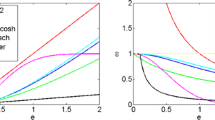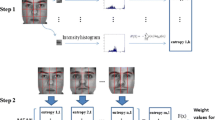Abstract
Recently sparse coding based on regression analysis has been widely used in face recognition research. Most existing regression methods add an extra constraint factor to the coding residual to make the fidelity term in the \(l_{2}\) loss approach the Gaussian or Laplace distribution. But the essence of these methods is that only the fidelity term of \(l_{1}\) loss or \(l_{2}\) loss is used. In this paper, weighted Huber constrained sparse coding (WHCSC) is used to study the robustness of face recognition in occluded environments, and alternating direction method of multipliers is used to solve the problem of model minimization. In WHCSC, we propose a sparse coding with weight learning and use Huber loss to determine whether the fidelity is a \(l_{2}\) loss or \(l_{1}\) loss. For the WHCSC model, the two kinds of classification modes and the two kinds of weight coefficients are further studied for the intra-class difference and the inter-class difference in the face image classification. Through a large number of experiments on a public face database, WHCSC shows strong robustness in face occlusion, corrosion and illumination changes comparing to the state-of-the-art methods.














Similar content being viewed by others
Explore related subjects
Discover the latest articles, news and stories from top researchers in related subjects.References
Liu L, Xiong C, Zhang H, Niu Z, Wang M, Yan S (2016) Deep aging face verification with large gaps. IEEE Trans Multimed 18(1):64–75
Kan M, Shan S, Zhang H, Lao S, Chen X (2015) Multi-view discriminant analysis. IEEE Trans Pattern Anal Mach Intell 38(1):188–194
Jiang X (2009) Asymmetric principal component and discriminant analyses for pattern classification. IEEE Trans Pattern Anal Mach Intell 31(5):931–937
Tolba AS, El-Baz AH, El-Harby AA (2006) Face recognition: a literature review. Int J Signal Process 2(1):88–103
Xu Y, Li Z, Zhang B, Yang J, You J (2017) Sample diversity, representation effectiveness and robust dictionary learning for face recognition. Inf Sci 375:171–182
Naseem I, Togneri R, Bennamoun M (2010) Linear regression for face recognition. IEEE Trans Pattern Anal Mach Intell 32(11):2106–2112
Wright J, Yang AY, Ganesh A, Sastry SS, Ma Y (2009) Robust face recognition via sparse representation. IEEE Trans Pattern Anal Mach Intell 31(2):210–227
Zhang L, Yang M, Feng X (2011) Sparse representation or collaborative representation: which helps face recognition? In: 2011 international conference on computer vision, Barcelona, pp 471–478
Jian Y, Lei L, Qian J, Ying T, Zhang F, Yong X (2017) Nuclear norm based matrix regression with applications to face recognition with occlusion and illumination changes. IEEE Trans Pattern Anal Mach Intell 39(1):156–171
Zhong D, Xie Z, Li Y, Han J (2015) Loose L 1/2 regularised sparse representation for face recognition. Comput Vis IET 9(2):251–258
Zheng J, Yang P, Chen S, Shen G, Wang W (2017) Iterative re-constrained group sparse face recognition with adaptive weights learning. IEEE Trans Image Process 26(5):2408–2423
Lin G, Yang M, Yang J, Shen L, Xie W (2018) Robust, discriminative and comprehensive dictionary learning for face recognition. Pattern Recogn 81:341–356
Boyd S, Parikh N, Chu E, Peleato B, Eckstein J (2010) Distributed optimization and statistical learning via the alternating direction method of multipliers. Found Trends Mach Learn 3(1):1–122
Zhang H, Wang S, Xu X, Chow TWS, Wu QMJ (2018) Tree2Vector: learning a vectorial representation for tree-structured data. IEEE Trans Neural Netw Learn Syst 29(11):1–15
Zhang H, Wang S, Zhao M, Xu X, Ye Y (2018) Locality reconstruction models for book representation. IEEE Trans Knowl Data Eng 30(10), pp Locality reconstruction models for book representation, 2018
Olshausen BA, Field DJ (2004) Sparse coding of sensory inputs. Curr Opin Neurobiol 14(4):481–487
Földiák P, Young MP (1998) Sparse coding in the primate cortex. In: Michael AA (ed) The handbook of brain theory and neural networks. MIT Press, Cambridge, pp 895–898
Liu Y, Li X, Liu C, Liu H (2016) Structure-constrained low-rank and partial sparse representation with sample selection for image classification. Pattern Recogn 59:5–13
Liu Y, Wu F, Zhang Z, Zhuang Y, Yan S (2010) Sparse representation using nonnegative curds and whey. In: 2010 IEEE conference on computer vision and pattern recognition, San Francisco, CA, pp 3578–3585
Gao S, Tsang WH, Chia LT, Zhao P (2010) Local features are not lonely—Laplacian sparse coding for image classification. In: 2010 IEEE computer society conference on computer vision and pattern recognition, San Francisco, CA, pp 3555–3561
Wang J, Yang J, Yu K, Lv F, Huang T, Gong Y (2010) Locality-constrained linear coding for image classification. In: 2010 IEEE computer society conference on computer vision and pattern recognition, San Francisco, CA, pp 3360–3367
Ramírez I, Lecumberry F, Sapiro G (2009) Universal priors for sparse modeling. In: 2009 3rd IEEE international workshop on computational advances in multi-sensor adaptive processing (CAMSAP), Aruba, Dutch Antilles, pp 197–200
Yang M, Zhang L, Yang J, Zhang D (2011) Robust sparse coding for face recognition. In: 2011 IEEE conference on computer vision and pattern recognition, pp. 625–632
Boyd S, Vandenberghe L, Faybusovich L (2006) Convex optimization. IEEE Trans Autom Control 51(11):233–237
Deng W, Yin W (2015) On the global and linear convergence of the generalized alternating direction method of multipliers. J Sci Comput 66(3):889–916
Goldstein T, Donoghue B, Setzer S (2014) Fast alternating direction optimization methods. SIAM J Imaging Sci 7(3):225–231
He B, Yuan X (2012) On non-ergodic convergence rate of Douglas–Rachford alternating direction method of multipliers. Numer Math 130(3):567–577
Li H, Hu H, Yip C (2017) Comments on “Iterative re-constrained group sparse face recognition with adaptive weights learning”. IEEE Trans Image Process 26(11):5475–5476
Acknowledgement
This paper is supported by the following foundations or programs, including Chongqing Innovative Project of Overseas Study (No. cx2018120), National Social Science Foundation of China (No. 17XFX013). The authors would like to thank the anonymous referees for their valuable comments and suggestions.
Author information
Authors and Affiliations
Corresponding author
Ethics declarations
Conflict of interest
We declare that we have no financial and personal relationships with other people or organizations that can inappropriately influence our work, there is no professional or other personal interest of any nature or kind in any product, service and/or company that could be construed as influencing the position presented in, or the review of, the manuscript entitled, “Weighted Huber Constrained Sparse Face Recognition”.
Additional information
Publisher's Note
Springer Nature remains neutral with regard to jurisdictional claims in published maps and institutional affiliations.
Rights and permissions
About this article
Cite this article
Lei, D., Jiang, Z. & Wu, Y. Weighted Huber constrained sparse face recognition. Neural Comput & Applic 32, 5235–5253 (2020). https://doi.org/10.1007/s00521-019-04024-z
Received:
Accepted:
Published:
Issue Date:
DOI: https://doi.org/10.1007/s00521-019-04024-z




